A Conceptual Modeling Framework for Hydrologic Ecosystem Services
Abstract
:1. Introduction
2. Materials and Methods
2.1. Hydrologic Model
2.2. ES Model and Methods
2.2.1. Water Provision ES
2.2.2. Flood Regulation ES
2.2.3. Sediment Retention ES
2.3. The Conceptual Framework and Workflow
2.4. Study Area
3. Results and Discussion
3.1. Hydrological Modeling
3.2. Ecosystem Services Modeling
3.2.1. Water Provision Index (WPI)
3.2.2. Flood Regulation Index (FRI)
3.2.3. Sediment Regulation Index (SRI)
4. Conclusions
Author Contributions
Funding
Acknowledgments
Conflicts of Interest
References
- De Groot, R.S.; Alkemade, R.; Braat, L.; Hein, L.; Willemen, L. Challenges in integrating the concept of ecosystem services and values in landscape planning, management and decision making. Ecol. Complex. 2010, 7, 260–272. [Google Scholar] [CrossRef]
- Millennium Ecosystem Assessment. Ecosystems and Human Well-being: Biodiversity Synthesis; World Resources Institute: Washington, DC, USA, 2005. [Google Scholar]
- Bagstad, K.J.; Semmens, D.J.; Waage, S.; Winthrop, R. A comparative assessment of decision-support tools for Ecosystem services quantification and valuation. Ecosyst. Serv. 2013, 5, e27–e39. [Google Scholar] [CrossRef]
- Nelson, E.; Mendoza, G.; Regetz, J.; Polasky, S.; Tallis, H.; Cameron, D.; Chan, K.; Daily, G.; Goldstein, J.; Kareiva, P.; et al. Modeling multiple Ecosystem Services, biodiversity conservation, commodity production, and tradeoffs at landscape scales. Front. Ecol. Environ. 2009, 7, 4–11. [Google Scholar] [CrossRef]
- Guswa, A.J.; Brauman, K.A.; Brown, C.; Hamel, P.; Keeler, B.L.; Sayre, S.S. Ecosystem Services: Challenges and opportunities for hydrologic modeling to support decision making. Water Resour. Res. 2014, 50, 4535–4544. [Google Scholar] [CrossRef]
- Bhatt, G.; Kumar, M.; Duffy, C.J. A tightly coupled GIS and distributed hydrologic modeling framework. Environ. Model. Softw. 2014, 62, 70–84. [Google Scholar] [CrossRef]
- Tallis, H.; Polasky, S. Mapping and Valuing Ecosystem Services as an Approach for Conservation and Natural-Resource Management. Ann. N. Y. Acad. Sci. 2009, 11621, 265–283. [Google Scholar] [CrossRef] [PubMed]
- Villa, F.; Bagstad, K.; Johnson, G.; Voigt, B. Scientific instruments for climate change adaptation: Estimating and optimizing the efficiency of ecosystem services provision. Economia Agraria y Recursos Naturales 2011, 11, 54–71. [Google Scholar]
- Zhang, Y.; Claus, H.; Yuan, X. Scale-dependent ecosystem service. In Ecosystem Services in Agricultural and Urban Landscapes; Wratten, S., Sandhu, H., Cullen, R., Costanza, R., Eds.; Wiley-Blackwell: Hoboken, NJ, USA, 2013; pp. 107–121. [Google Scholar]
- Scholes, R.J.; Reyers, B.; Bigg, R.; Spierenburg, M.J.; Duriappah, A. Multi-scale and cross-scale assessments of scoio-ecological systems and their Ecosystem Services. Curr. Opin. Environ. Sust. 2013, 5, 16–25. [Google Scholar] [CrossRef]
- Koch, E.W.; Barbier, E.B.; Silliman, B.R.; Reed, D.J.; Perillo, G.M.; Hacker, S.D.; Granek, E.F.; Primavera, J.H.; Muthiga, N.; Polasky, S.; et al. Non-linearity in Ecosystem Services: Temporal and spatial variability in coastal protection. Front. Ecol. Environ. 2009, 7, 29–37. [Google Scholar] [CrossRef]
- Cline, J.C.; Lorenz, J.J.; Swain, E.D. Linking Hydrologic Modeling and Ecologic Modeling: An Application of Adaptive Ecosystem Management in the Everglades Mangrove Zone of Florida Bay. In Proceedings of the International Environmental Modelling and Software Society iEMSs 2004 International Conference, Osnabrück, Germany, 14–17 June 2004. [Google Scholar]
- Wlotzka, M.; Haas, E.; Kraft, P.; Heuveline, V.; Klatt, S.; Kraus, D.; Breuer, L. Dynamic Simulation of Land Management Effects on Soil N2O Emissions using a coupled Hydrology-Ecosystem Model. Available online: https://journals.ub.uni-heidelberg.de/index.php/emcl-pp/article/view/11824 (accessed on 31 January 2018).
- Leh, M.D.K.; Matlock, M.D.; Cummings, E.C.; Nalley, L.L. Quantifying and mapping multiple ecosystem services change in West Africa. Agric. Ecosyst. Environ. 2013, 165, 6–18. [Google Scholar] [CrossRef]
- Gao, J.; Li, F.; Gao, H.; Zhou, C.; Zhang, X. The impact of land-use change on water-related ecosystem services: A study of the Guishui River Basin, Beijing, China. J. Clean. Prod. 2017, 163, S148–S155. [Google Scholar] [CrossRef]
- Samal, N.; Wollheim, W.; Zuidema, S.; Stewart, R.; Zhou, Z.; Mineau, M.; Huber, M. A coupled terrestrial and aquatic biogeophysical model of the Upper Merrimack River watershed, New Hampshire, to inform ecosystem services evaluation and management under climate and land-cover change. Ecol. Soc. 2017, 22, 18. [Google Scholar] [CrossRef]
- Yang, L.; Zhang, L.; Li, Y.; Wu, S. Water-related ecosystem services provided by urban green space: A case study in Yixing City (China). Landsc. Urban Plan. 2015, 136, 40–51. [Google Scholar] [CrossRef]
- Bai, Y.; Zheng, H.; Ouyang, Z.; Zhuang, C.; Jiang, B. Modeling hydrological ecosystem services and tradeoffs: A case study in Baiyangdian watershed, China. Environ. Earth Sci. 2013, 70, 709–718. [Google Scholar] [CrossRef]
- Notter, B.; Hurni, H.; Wiesmann, U.; Abbaspour, K. Modelling water provision as an ecosystem service in a large East African river basin. Hydrol. Earth Syst. Sci. 2012, 16, 69. [Google Scholar] [CrossRef]
- Schmalz, B.; Kruse, M.; Kiesel, J.; Müller, F.; Fohrer, N. Water-related ecosystem services in Western Siberian lowland basins—Analysing and mapping spatial and seasonal effects on regulating services based on ecohydrological modelling results. Ecol. Indic. 2016, 71, 55–65. [Google Scholar] [CrossRef]
- Logsdon, R.A.; Chaubey, I. A quantitative approach to evaluating ecosystem services. Ecol. Model. 2013, 257, 57–65. [Google Scholar] [CrossRef]
- Duda, P.B.; Hummel, P.R.; Donigian, A.S., Jr.; Iimhoff, J.C. BASINS/HSPF Model Use, Calibration and Validation. Trans. ASABE 2012, 55, 1523–1547. [Google Scholar] [CrossRef]
- National Exposure Research Laboratory (U.S.). Hydrological simulation program--FORTRAN user’s manual for version 11. Available online: http://purl.access.gpo.gov/GPO/LPS35019 (accessed on 31 January 2018).
- Alarcon, V.J.; Mcanally, W.; Diaz-Ramirez, J.; Martin, J.; Cartwright, J. A Hydrological Model of the Mobile River Watershed, Southeastern USA. AIP Conf. Proc. 2009, 1148, 641–645. [Google Scholar]
- Hsu, S.M.; Chiou, L.B.; Lin, G.F.; Chao, C.H.; Wen, H.Y.; Ku, C.Y. Applications of simulation technique on debris-flow hazard zone delineation: A case study in hualien county, taiwan. Nat. Hazards Earth Syst. Sci. 2010, 10, 535–545. [Google Scholar] [CrossRef]
- Chen, J.; Theller, L.; Gitau, M.W.; Engel, B.A.; Harbor, J.M. Urbanization impacts on surface runoff of the contiguous United States. J. Environ. Manag. 2017, 187, 470–481. [Google Scholar] [CrossRef] [PubMed]
- Hayashi, S.; Murakami, S.; Xu, K.; Watanabe, M.; Xu, B. Daily runoff simulation by an integrated catchment model in the middle and lower regions of the changjiang basin, china. J. Hydrol. Eng. 2008, 13, 846–862. [Google Scholar] [CrossRef]
- Tzoraki, O.; Nikolaidis, N.P. A generalized framework for modeling the hydrologic and biogeochemical response of a Mediterranean temporary river basin. J. Hydrol. 2007, 346, 112–121. [Google Scholar] [CrossRef]
- Choi, W.; Pan, F.; Wu, C. Impacts of climate change and urban growth on the streamflow of the Milwaukee River (Wisconsin, USA). Reg. Environ. Chang. 2017, 17, 889–899. [Google Scholar] [CrossRef]
- U.S. Geological Survey. USGS National Elevation Dataset (NED) 1 arc-second Downloadable Data Collection from The National Map 3D Elevation Program (3DEP)—National Geospatial Data Asset (NGDA) National Elevation Data Set (NED): U.S. Geological Survey; U.S. Geological Survey: Reston, VA, USA, 2016.
- Vogelmann, J.E. Completion of the 1990s national land cover data set for the conterminous United States from Landsat thematic mapper data and ancillary data sources. Photogramm. Eng. Remote Sens. 2001, 67, 650–655. [Google Scholar]
- Serbin, S.P.; Kucharik, C.J. Spatiotemporal mapping of temperature and precipitation for the development of a multidecadal climatic dataset for Wisconsin. J. Appl. Meteorol. Climatol. 2009, 48, 742–757. [Google Scholar] [CrossRef]
- U.S. Geological Survey. National Water Information System data available on the World Wide Web (USGS Water Data for the Nation). 2016. Available online: http://waterdata.usgs.gov/nwis/ (accessed on 10 June 2012).
- Tennant, D.L. Instream flow regimens for fish, wildlife, recreation and related environmental resources. Fisheries 1976, 1, 6–10. [Google Scholar] [CrossRef]
- De Guenni, L.B.; Cardoso, M.; Goldammer, J.; Hurtt, G.; Mata, L.J.; Ebi, K.; House, J.; Valdes, J. Regulation of natural hazards: Floods and fires. In Ecosystems and Human Well-being: Current State and Trends; Norgaard, R., Ed.; Island Press: Washington, DC, USA, 2005. [Google Scholar]
- Soil Survey Staff, Natural Resources Conservation Service, United States Department of Agriculture. Web Soil Survey. Available online: http://websoilsurvey.nrcs.usda.gov/ (accessed on 25 September 2018).
- Wisconsin. Department Of Natural Resources. The state of the Milwaukee River Basin. Available online: https://lccn.loc.gov/2002418368 (accessed on 31 January 2018).
- Bajracharya, R.M.; Lal, R. Seasonal Soil Loss and Erodibility Variation on a Miamian Silt Loam Soil. (Soil and Water Management and Conservation). Soil Sci. Soc. Am. J. 1992, 56, 1560. [Google Scholar] [CrossRef]
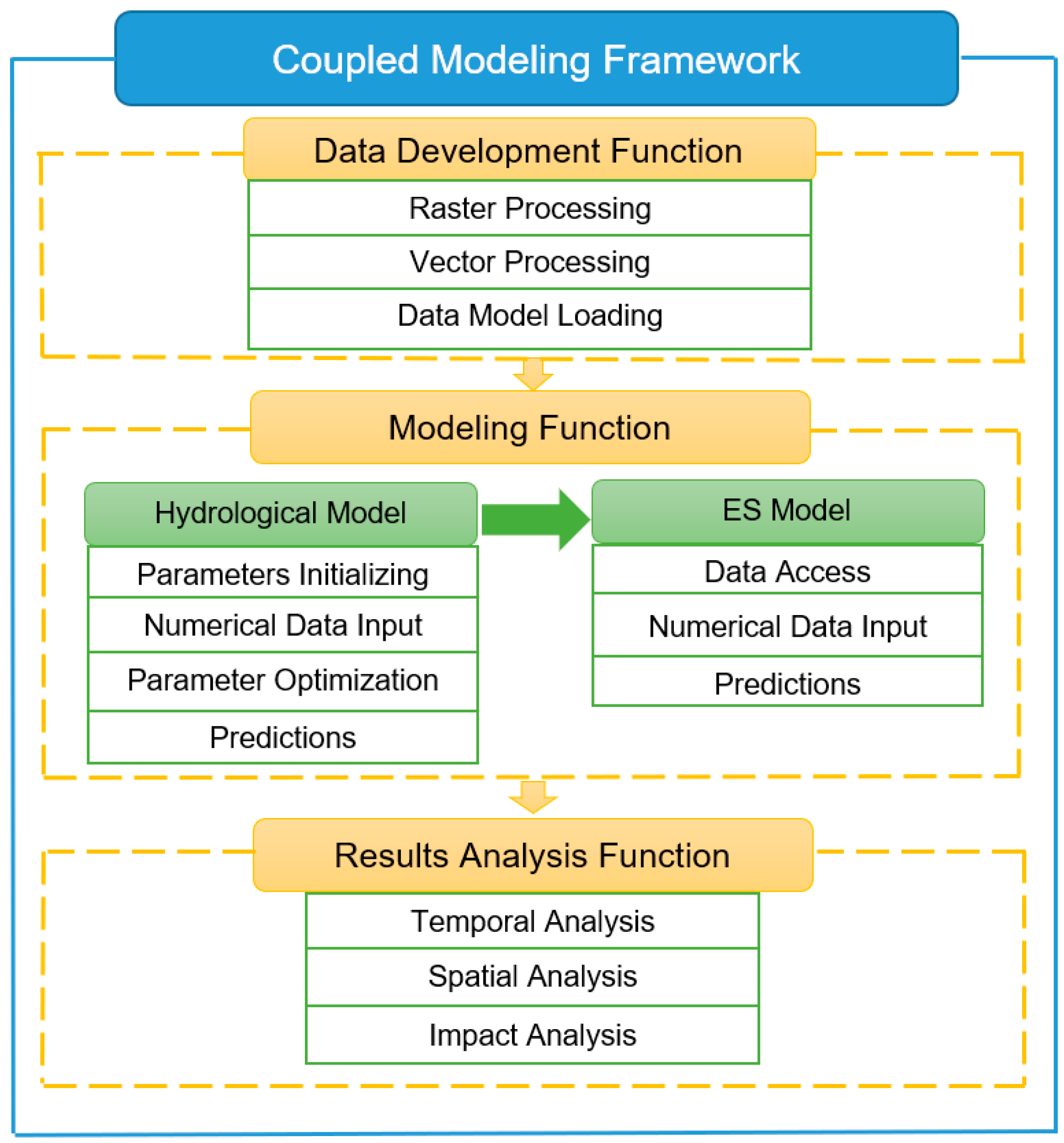
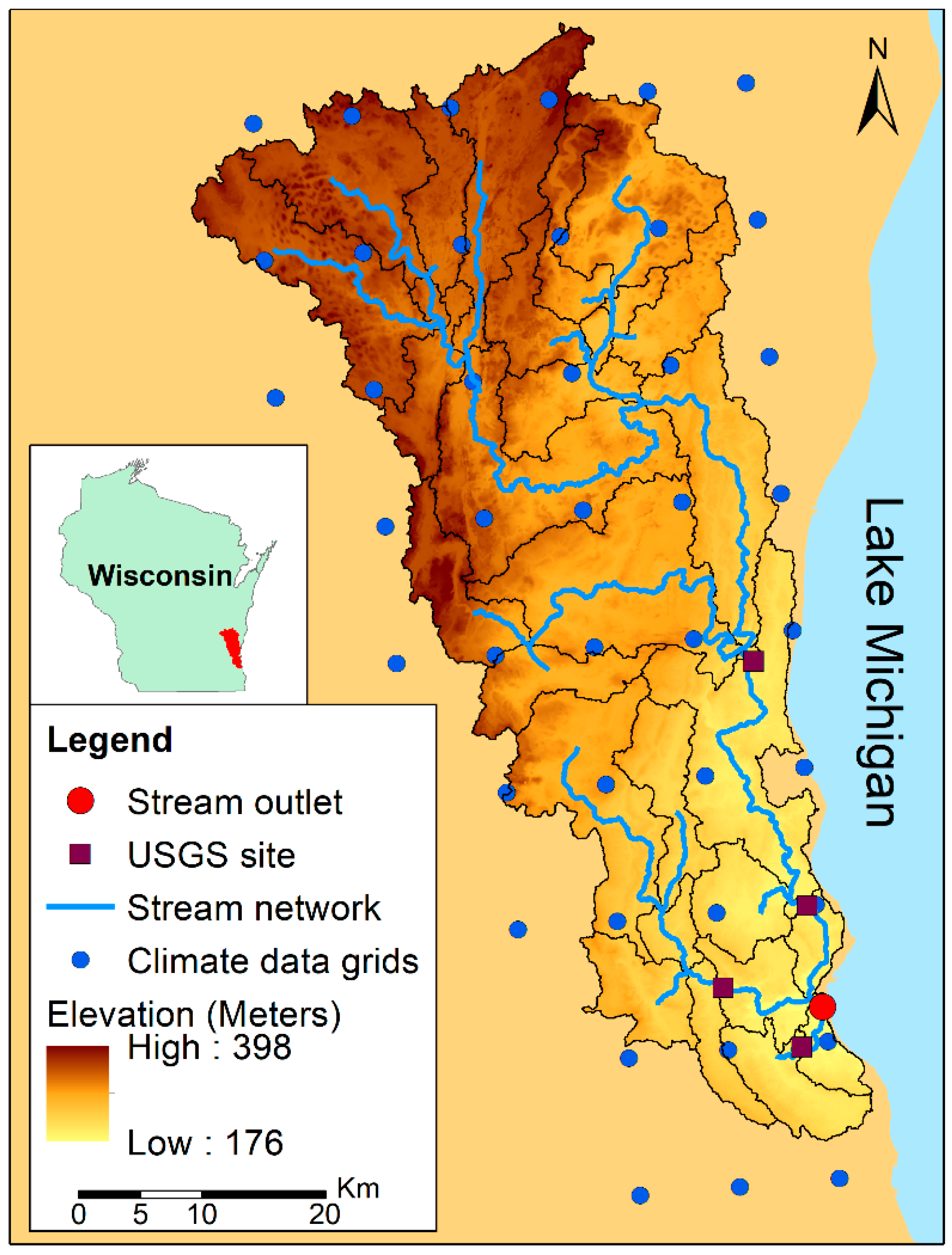
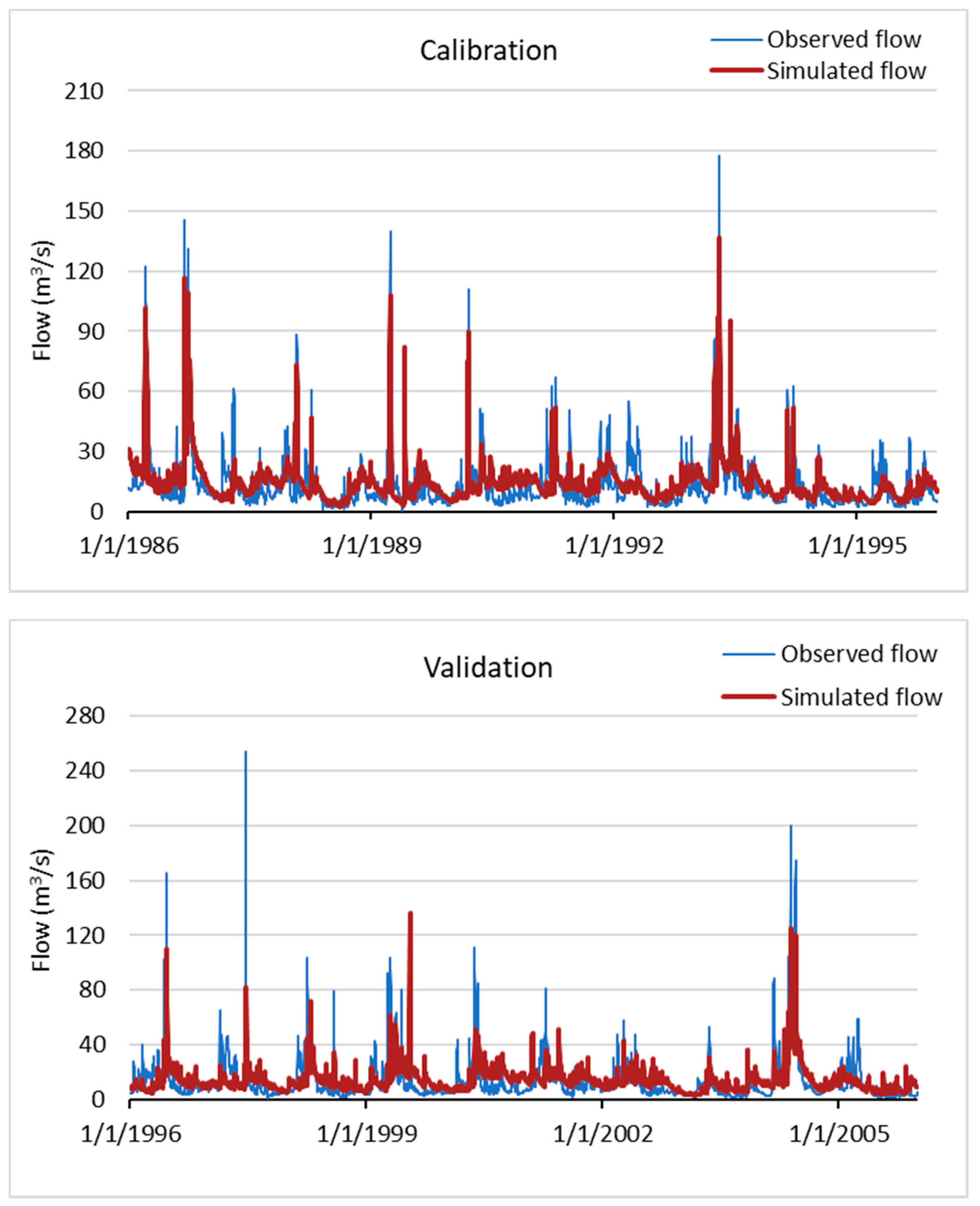
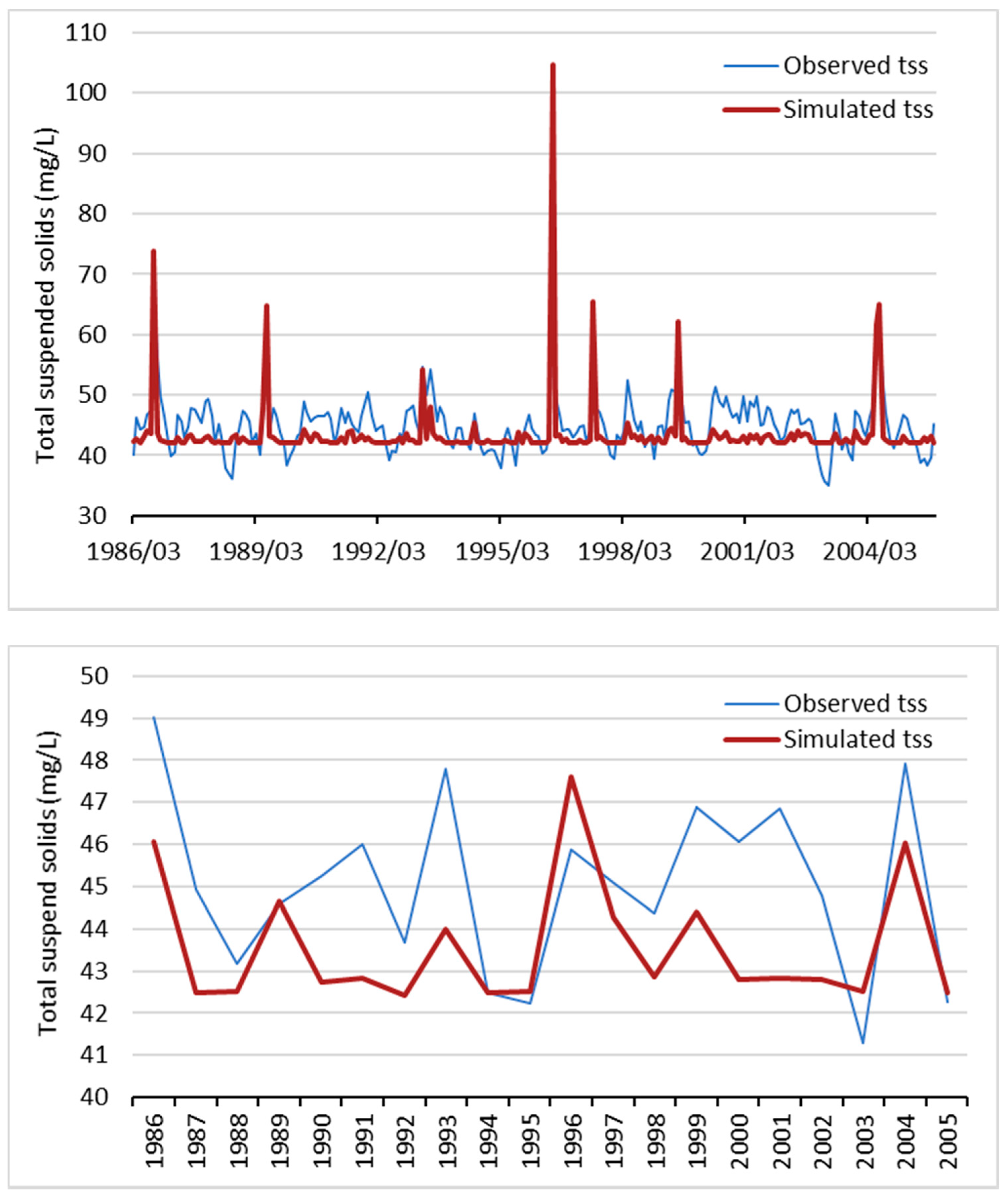
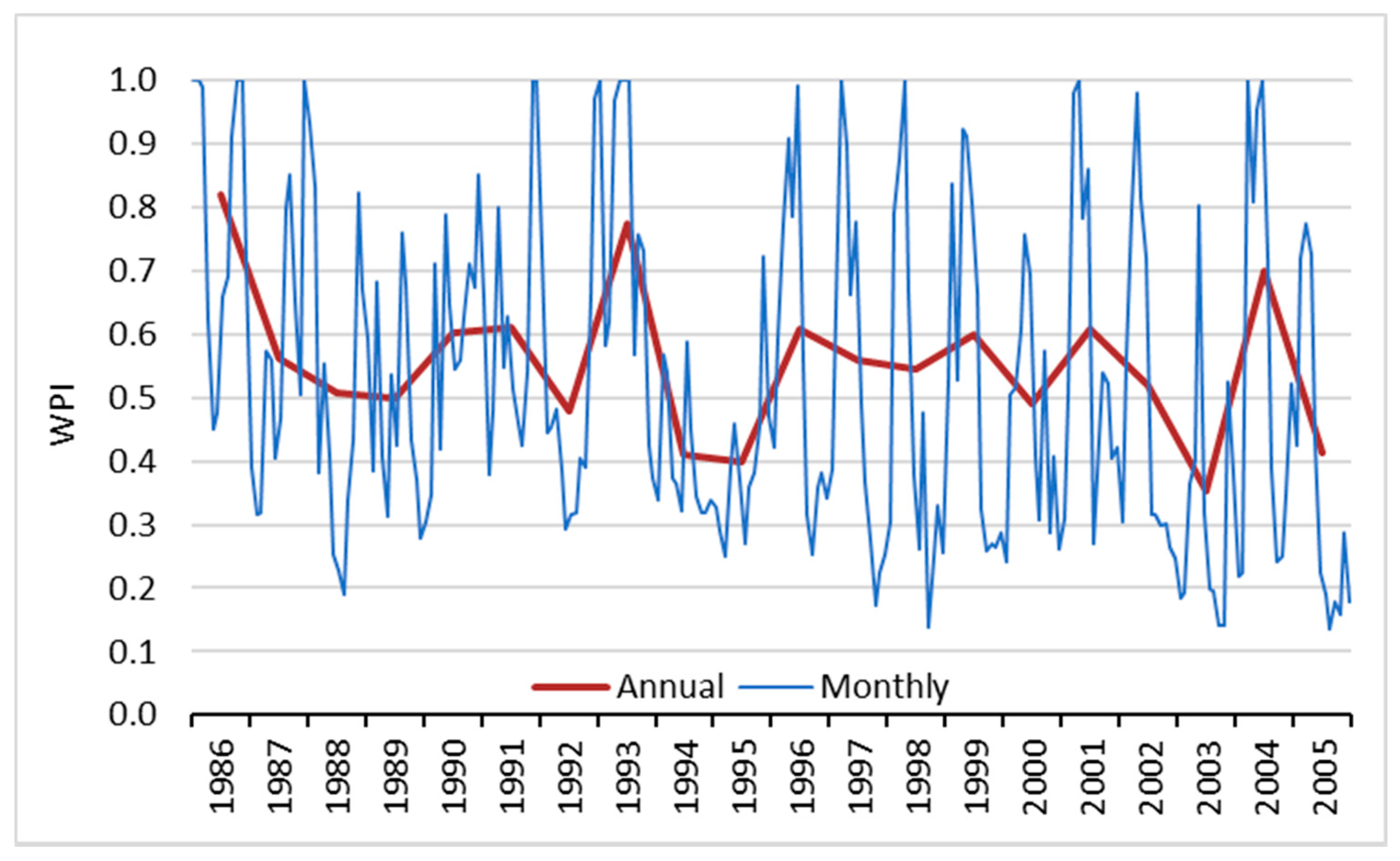
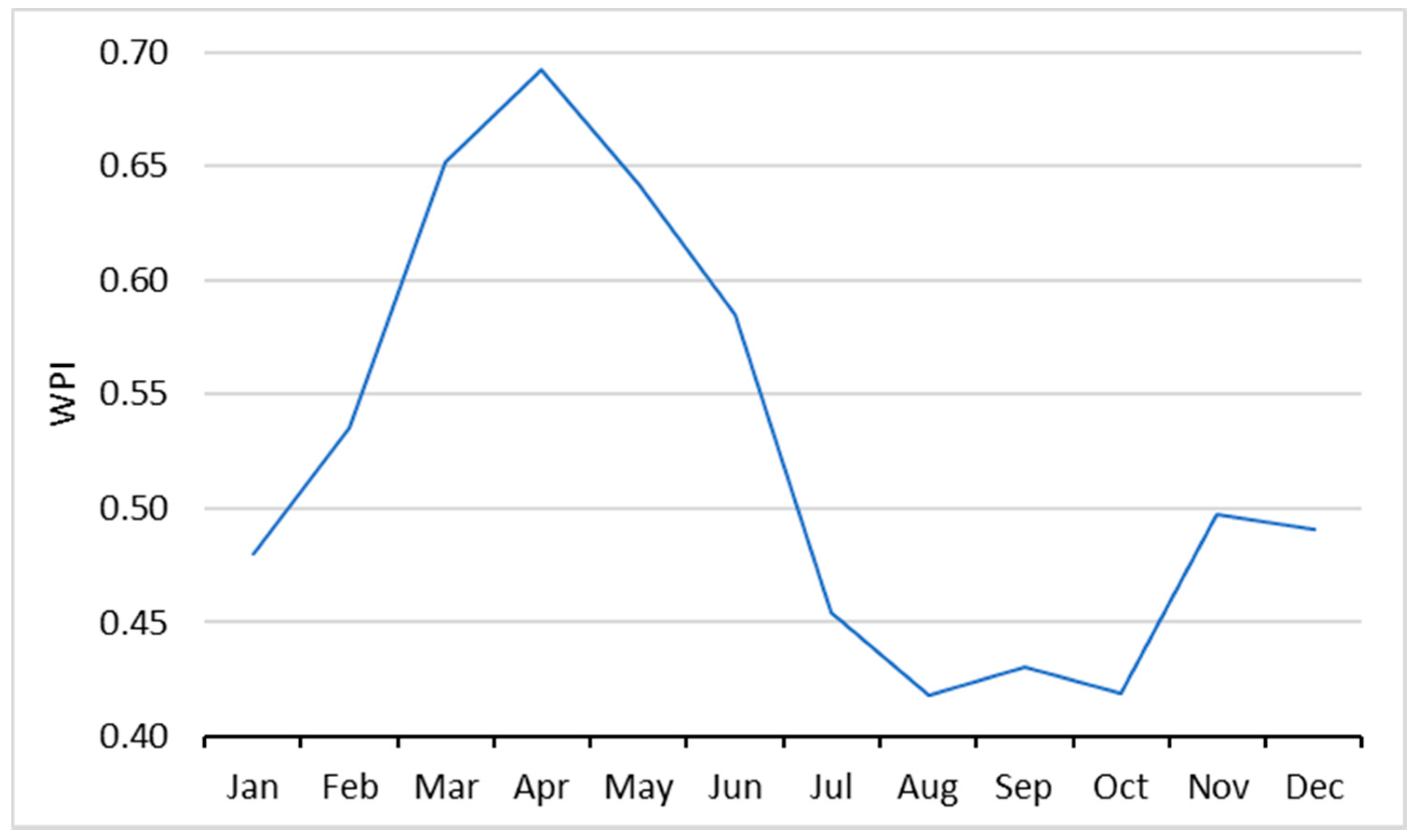
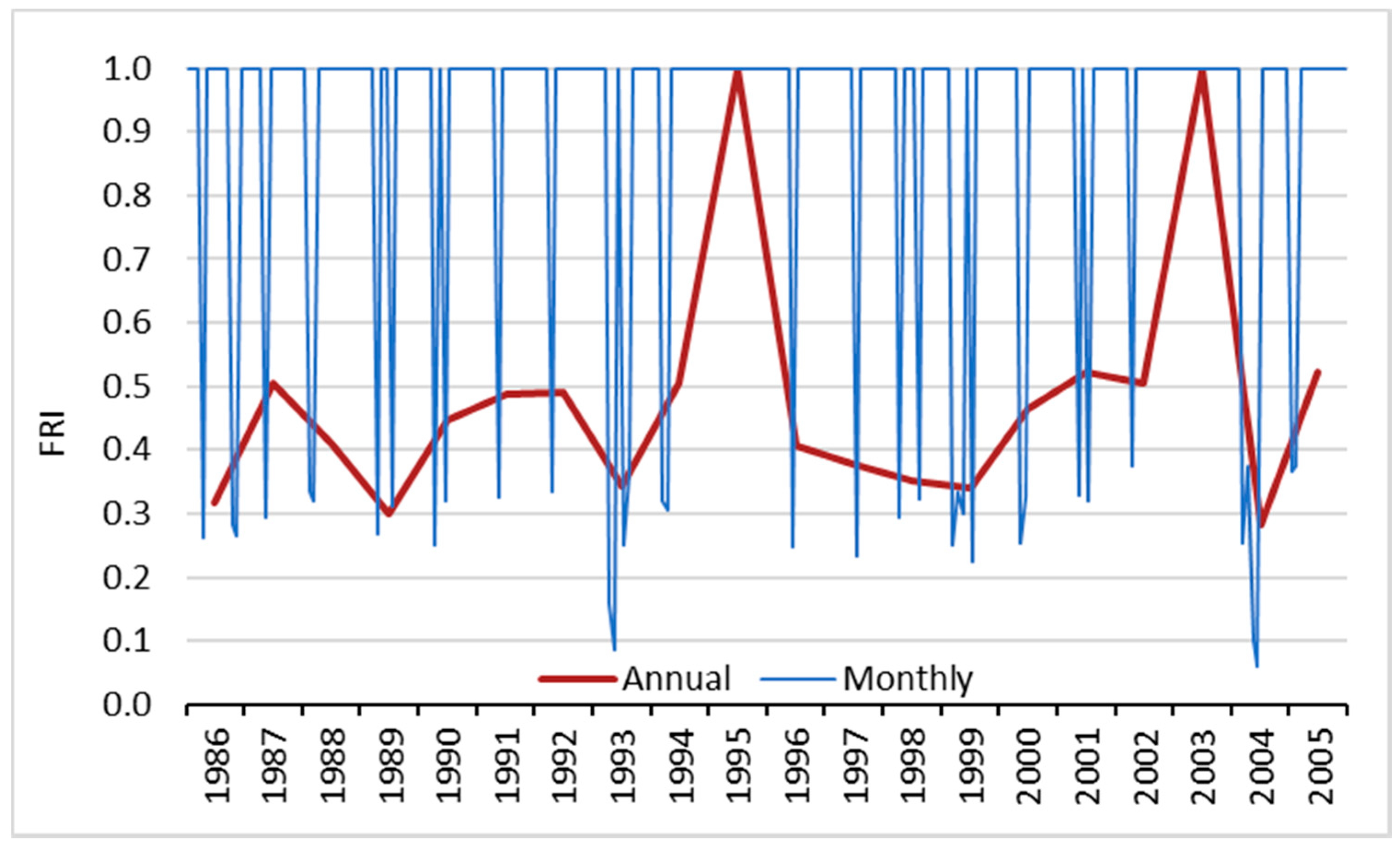

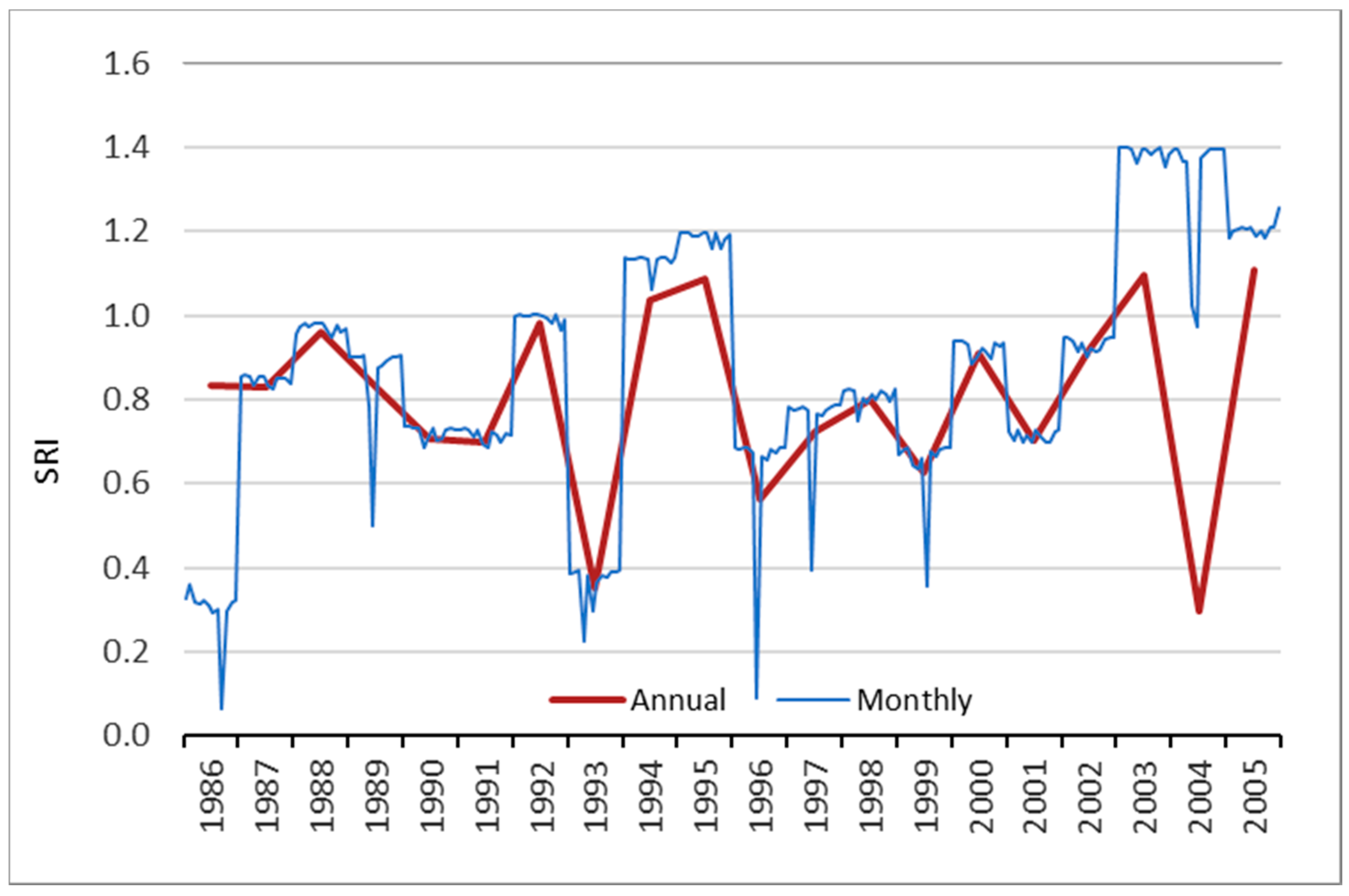
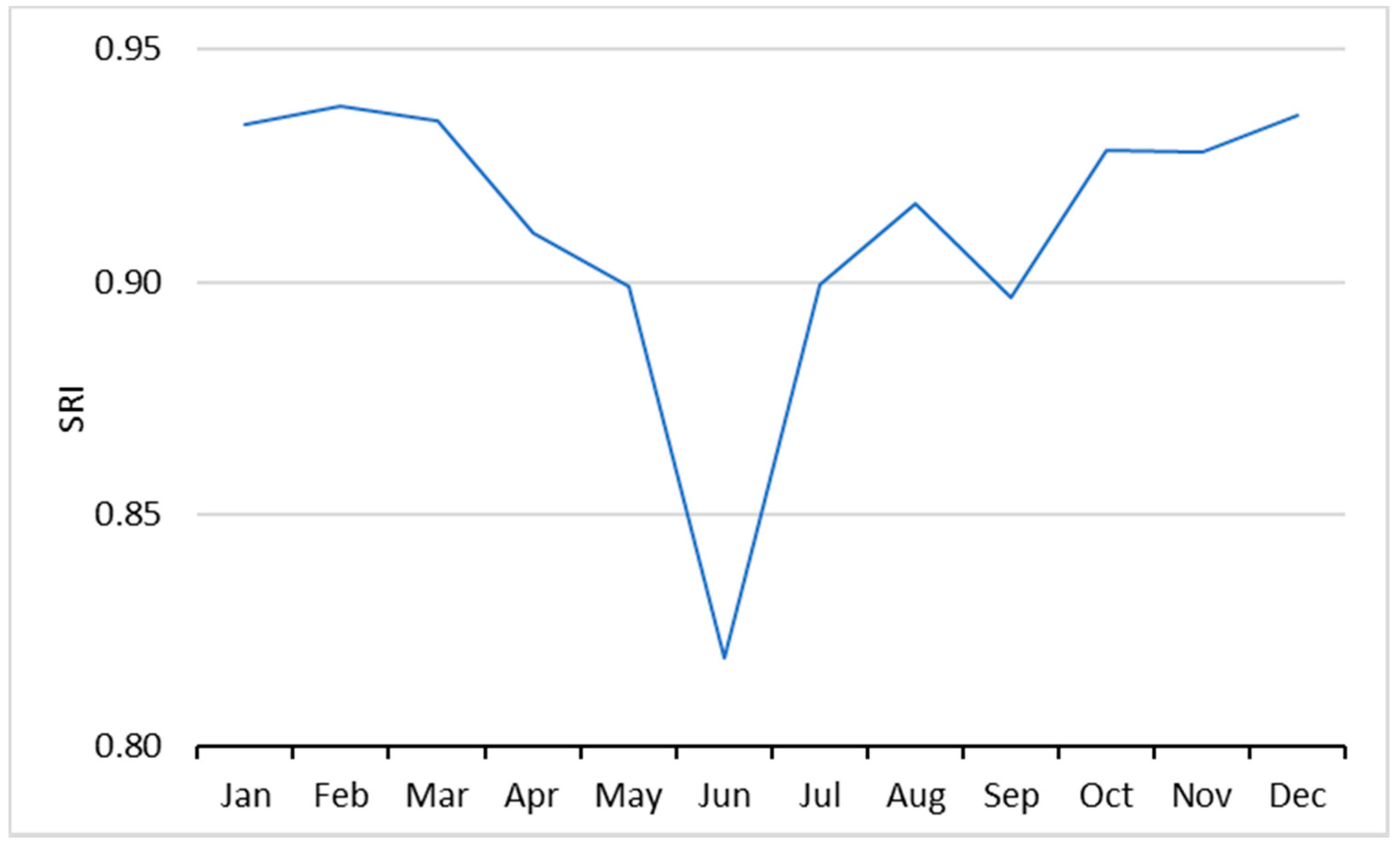
| Data sets | Spatial Resolution | Source |
|---|---|---|
| Digital elevation data | 30 m | US Geological Survey (USGS) [30] |
| Land cover map | 30 m | National Land Cover Database (NLCD) [31] |
| Climate data | 8 km | University of Wisconsin-Madison [32] |
| Streamflow and sediments yield data | N/A | USGS [33] |
| Category | A | B | C | |
|---|---|---|---|---|
| Month | ||||
| Jan | 3 | 14 | 3 | |
| Feb | 4 | 14 | 2 | |
| Mar | 8 | 11 | 1 | |
| Apr | 9 | 11 | 0 | |
| May | 8 | 12 | 0 | |
| Jun | 6 | 12 | 2 | |
| Jul | 1 | 13 | 6 | |
| Aug | 1 | 16 | 3 | |
| Sep | 2 | 11 | 7 | |
| Oct | 1 | 13 | 6 | |
| Nov | 3 | 14 | 3 | |
| Dec | 4 | 10 | 6 | |
| Category | A | B | |
|---|---|---|---|
| Month | |||
| Jan | 19 | 1 | |
| Feb | 18 | 2 | |
| Mar | 16 | 4 | |
| Apr | 10 | 10 | |
| May | 13 | 7 | |
| Jun | 16 | 4 | |
| Jul | 15 | 5 | |
| Aug | 18 | 2 | |
| Sep | 20 | 0 | |
| Oct | 19 | 1 | |
| Nov | 19 | 1 | |
| Dec | 20 | 0 | |
| Category | A | B | C | |
|---|---|---|---|---|
| Month | ||||
| Jan | 2 | 14 | 4 | |
| Feb | 2 | 14 | 4 | |
| Mar | 2 | 14 | 4 | |
| Apr | 2 | 14 | 4 | |
| May | 2 | 15 | 3 | |
| Jun | 5 | 12 | 3 | |
| Jul | 3 | 13 | 4 | |
| Aug | 2 | 15 | 3 | |
| Sep | 2 | 14 | 4 | |
| Oct | 2 | 14 | 4 | |
| Nov | 2 | 14 | 4 | |
| Dec | 2 | 14 | 4 | |
© 2019 by the authors. Licensee MDPI, Basel, Switzerland. This article is an open access article distributed under the terms and conditions of the Creative Commons Attribution (CC BY) license (http://creativecommons.org/licenses/by/4.0/).
Share and Cite
Pan, F.; Choi, W. A Conceptual Modeling Framework for Hydrologic Ecosystem Services. Hydrology 2019, 6, 14. https://doi.org/10.3390/hydrology6010014
Pan F, Choi W. A Conceptual Modeling Framework for Hydrologic Ecosystem Services. Hydrology. 2019; 6(1):14. https://doi.org/10.3390/hydrology6010014
Chicago/Turabian StylePan, Feng, and Woonsup Choi. 2019. "A Conceptual Modeling Framework for Hydrologic Ecosystem Services" Hydrology 6, no. 1: 14. https://doi.org/10.3390/hydrology6010014
APA StylePan, F., & Choi, W. (2019). A Conceptual Modeling Framework for Hydrologic Ecosystem Services. Hydrology, 6(1), 14. https://doi.org/10.3390/hydrology6010014





